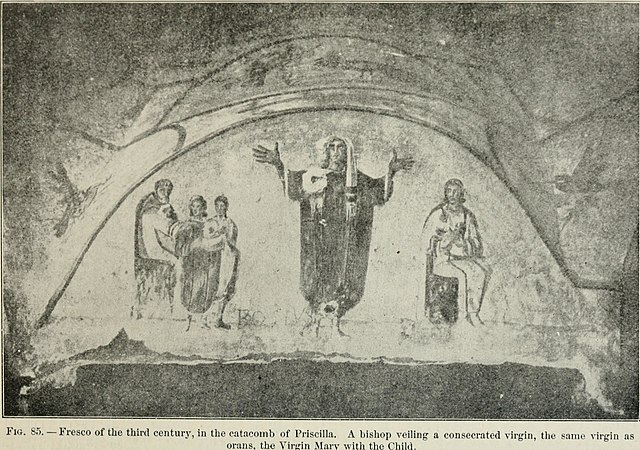Orans, a loanword from Medieval Latin orans translated as "one who is praying or pleading", also orant or orante, as well as lifting up holy hands, is a posture or bodily attitude of prayer, usually standing, with the elbows close to the sides of the body and with the hands outstretched sideways, palms up. The orans posture of prayer has a Scriptural basis in 1 Timothy 2:8: "I desire, then, that in every place the men should pray, lifting up holy hands without anger or argument" (NRSV). It was common in early Christianity and can frequently be seen in early Christian art, being advised by several early Church Fathers, who saw it as "the outline of the cross". In modern times, the orans position is still preserved in Oriental Orthodoxy, as when Coptic Christian believers pray the seven canonical hours of the Agpeya at fixed prayer times. The orans also occurs within parts of the Catholic, Oriental Orthodox, Eastern Orthodox, Lutheran, and Anglican liturgies, Pentecostal and charismatic worship, and the ascetical practices of some religious groups.

An early Christian painting of Noah praying in the gesture of orant
Fresco in the Catacomb of Priscilla showing a Christian woman wearing a headcovering and praying in the orant posture
Christian man praying in the gesture of orant, Catacombs of Domitilla, Rome
Reuben Morgan praying in the orans posture at an event in Zagreb, Croatia.
Early Christian art and architecture
Early Christian art and architecture is the art produced by Christians, or under Christian patronage, from the earliest period of Christianity to, depending on the definition, sometime between 260 and 525. In practice, identifiably Christian art only survives from the 2nd century onwards. After 550, Christian art is classified as Byzantine, or according to region.
Jesus healing the bleeding woman, Roman catacombs, 300–350
The Brescia Casket, 4th-century ivory
Good Shepherd from the Catacomb of Priscilla, 250–300
Noah praying in the Ark, from a Roman catacomb







